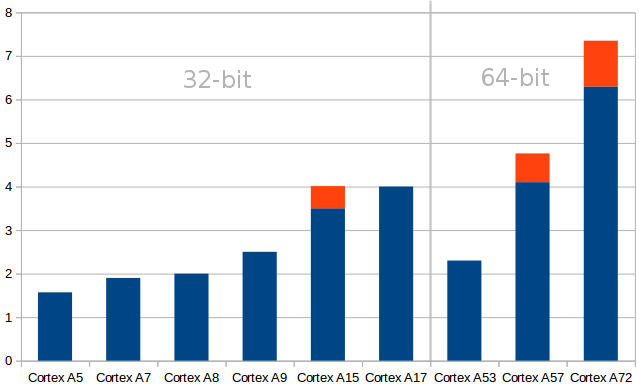Many people assume newer processors will be faster, or that 64-bit processor will provide a performance boost compared to 32-bit processors, but the reality can be quite different, and I’ve decided to have a look at ARM Cortex-A cores using ARMv7 (32-bit) and ARMv8 (64-bit) architecture, and see what kind of integer performance you can expect from each at a given frequency. To do so, I’ve simply use DMIPS/Mhz (Dhrystone MIPS/Megahertz) values listed on Wikipedia.

Drystone benchmark has no floating-point operating, so it’s a pure integer benchmark. I’m only looking at ARM core here, and once integrated in an SoC, other parameters like memory bandwidth, amount of cache, GPU, etc.. will greatly affect the overall system performance. The figure above are per MHz, and it does not mean for example that a Cortex A5 processor will be slower than a Cortex A7 processor, as can be seen by the comparison between Amlogic S805 (4x Cortex A5) and Broadcom BCM2835 (4x Cortex A7), which shows the Amlogic processor is about 40% faster due to higher clock speed.
With that in mind, it can be seen than you may not expect all recent Cortex A53 processors to outperform existing Cortex A15 and A17 processors, and in some case even Cortex A9 processors, and the real performance benefit with 64-bit cores only start to show with Cortex A57, and especially Cortex A72 cores which is some cases could be twice as fast as Cortex A15 cores. The red zone on top of some bars represents the possible performance variation due to different implementations of the cores.
ARMv8 also brings some other improvement such as additional cryptographic extensions, an increase in the number of SIMD/floating point, and general purpose registers, and more, as shortly explained in that article. All of these should also deliver benefits provided the firmware and applications support them.

Jean-Luc started CNX Software in 2010 as a part-time endeavor, before quitting his job as a software engineering manager, and starting to write daily news, and reviews full time later in 2011.
Support CNX Software! Donate via cryptocurrencies, become a Patron on Patreon, or purchase goods on Amazon or Aliexpress




